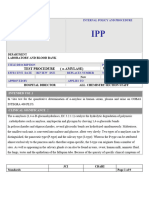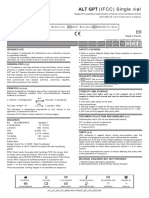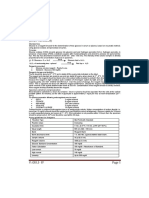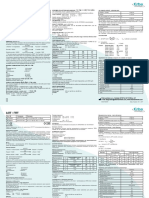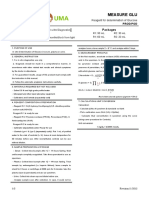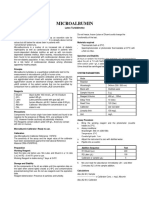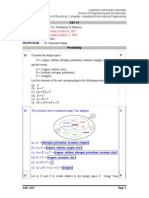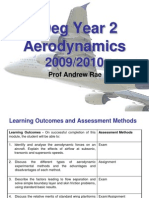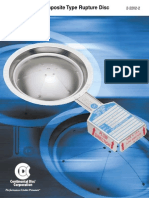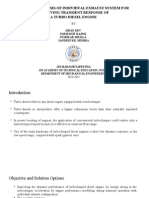FRUCTOSAMINE Ref.
: 97
Instruction for use
Intended use . System for fructosamine determination by fixed-time
kinetic method in serum samples.
2. ) - Reagent 2 - Store at 2 - 8 ºC.
Reagent label bears expiration date. Buffer pH 10.4 (625 mmol/L);
sodium azide (14.6 mmol/L).
Professional use.
[For in vitro diagnostic use.]
3. < - Calibrator - Check the calibrator concentration on the
bottle label. Store at 2 - 8 ºC.
Lyophilized reagent. Reagent label bears expiration date. Glycated Bovine
Test principle . Glucose binds to amino groups of proteins yielding a albumin, Buffer pH 7.4 (50 mmol/L); and sodium azide (14.6 mmol/L).
Schiff's base (aldimine) that after a molecular rearrange, transforms to a
stable ketoamine generally known as fructosamine1. Stability . Unopened reagents, when stored at indicated temperature,
are stable up to expiration date shown on the label. During handling, the
In alkaline pH fructosamine is converted to an enolic form that reduces reagents are subject to chemical and microbial contamination that may
nitro blue tetrazolium to a “purple formazan”. The absorbance difference, lead to reduced stability.
after incubation in 10 minutes and 15 minutes, is proportional to
fructosamine concentration in the sample2. The system calibration is
performed with bovine matrix calibrator, calibrated with glycated Precautions and warnings
polylysine. The results are presented as micromoles/liter (mmol/L).
Disposal of all waste material should be in accordance with local
guidelines.
Summary . Fructosamine determination, yielded from the bind of
glucose and plasmatic proteins, is based on its reduction ability in alkaline The usual security cares should be applied on the reagent handling. Do not
medium. Other reducer agents may be present in serum sample and pipette the reagent with mouth.
interferes in the assay. Labtest incorporated uricase and a clarifier agent
based on detergents in the Fructosamine system in order to minimize the The reagents contain sodium azide as preservative. Avoid ingestion. In
interferences of uric acid and lipemia. case of eyes contact, immediately flush eyes with plenty of water and get
medical assistance.
The assay calibration with the glycated albumin calibrator in vitro,
calibrated by glycated polylysine containing glucose labeled with 14C, Sodium azide may react with lead and copper plumbing to form highly
makes that small variations of test condition do not importantly interfere2. explosive metal azides. On disposal, flush with a large volume of water to
The system benefits are more consistent results with more reproducibility prevent azide accumulation.
and accuracy.
Temperature and incubation time controls during the measurement must
The system uses a Work Reagent stable for 30 days, if stored at 2 - 8 ºC. be rigorous. 1 ºC difference in the temperature produces 5% error, while 1
The system also allows preparing the volume of the Work Reagent needed minute difference during the DA measurement produces a 20% error.
to one measure of the Fructosamine concentration.
Deterioration . The Working Reagent is an alkaline solution
It is easily applied to most automatic equipments which are able to
(pH= 10.3) and, as such, is instable when expose to ambient
measure, in a kinetic method, absorbances difference at 530 nm5.
atmosphere. In order to conserve its performance, the Working Reagent
must be opened only the time needed to get the volume desired. Keep the
Methodology . NBT reduction. bottle tightly closed.
Reagents Materials required not provided
1. ( - Reagent 1 - Store at 2 - 8 ºC.
Reagent label bears expiration date. Buffer pH 7.3 (83 mmol/L); nitro blue
tetrazolium (NBT) (967 mmol/L); uricase (³5000 U/L); sodium azide
1. A constant temperature water bath (37 ºC).
2. Photometer capable of measuring absorbance at 510 - 550 nm.
(14.6 mmol/L) stabilizer and surfactants.
3. Pipettes to measure reagents and samples.
4. Timer
01 English - Ref.: 97
� Specimen collection and preparation Manual procedure
Use serum or plasma (EDTA and heparin) without hemolysis. This procedure is not applied to automated and semi-automated
The analite is reportedly stable for about 7 days at 2 - 8 ºC and 3 months at equipments only with flow cuvette system. It is available application
-20 ºC. procedures to automated and semi-automated equipments.
A Standard Operating Procedure (POP) should be established to establish See notes 1, 2 and 3.
appropriate procedures for the collection, preparation and storage of the
sample. We emphasize that the errors due to the sample may be much Set up two tubes and proceed as follows:
larger than the errors that occurred during the analytical procedure.
Unknown Calibrator
Working Reagent 1.0 mL 1.0 mL
No known test method can offer complete assurance that human blood
samples will not transmit infectious diseases. Therefore, all blood
derivatives should be considered potentially infectious. Incubate 2 minutes at 37 ºC.
Sample 0.050 mL ------
Interference Calibrator ------ 0.050 mL
Bilirubin up to 8.0 mg/dL, and glucose up to 1000 mg/dL do not interfere
significantly. Mix and incubate exactly 10 minutes in a water bath at 37 ºC. Measure the
absorbance (A1) of the Unknown and Calibrator against water at 530 nm
High ascorbic acid concentrations over 3.0 mg/dL and hemoglobin (510 - 550). Continue the reaction for more exactly 5 minutes and
concentrations over 100 mg/dL result in significant negative interference. determine the absorbance (A2) of the Unknown and Calibrator against
water at 530 nm (510 - 550).
Triglycerides concentrations up to 1000 mg/dL and uric acid up to
14 mg/dL do not significantly interfere. Calibration . The concentration is traceable to a proteic Calibrator
calibrated with glycated polylysine sample with glucose 14C labeled.
Preparing the reagents
Manual calibrations
Two points calibration.
Working reagent . Use one bottle of Reagent 1 and Reagent 2 for Calibrator included (Ref.: 97.3).
preparing Working Reagent. Transfer all the contents of one Reagent 2
bottle to one Reagent 1 bottle and mix by inversion.
Calibration frequency
Perform a new calibration weekly and in the following situations:
The Working Reagent is stable 30 days at 2 - 8 ºC, when no chemistry or
When the internal quality control indicates.
microbiological contamination occurs (See Calibration).
After reagent lot change.
When a new Working Reagent is used.
The Working Reagent is an alkaline solution (pH = 10.3) and as such is
unstable when exposed to the ambient atmosphere. Therefore, this
Automatic Systems
reagent may have its performance compromised unpredictably if kept
Blank of reagents: water or 0.85% NaCl (150 mmol/L);
open, either in the automatic analyzer or on the bench. To preserve
Two points calibration
performance, the working reagent should only remain open for as long as
Calibrator included (Ref. 97.3).
necessary to obtain the volume to be used. Store tightly closed.
Calibration frequency
Optionally, a lower volume of the Working Reagent may be prepared by
Perform a new calibration weekly and in the following situations:
using the volume proportion 3:2 of the Reagent 1 and Reagent 2,
When the internal quality control indicates.
respectively.
After reagent lot change.
When a new Working Reagent is used.
The Working Reagent contains 50 mmol/L phosphate buffer; 250 mmol/L
carbonate buffer; 530 mmol/L nitrotetrazolium blue, uricase ³3000 U/L,
detergents and stabilizers at pH 10.3.
Quality control . For quality control use Qualitrol H Level 1 and
Qualitrol H Level 2 or other suitable control material. The limits and control
interval must be adapted to the laboratory requirements. Each laboratory
Calibrator . Dissolve the Calibrator bottle (nº 3) contents in 2.0 mL should establish corrective measures to be taken if values fall outside the
water reagent. Wait 30 minutes. Mix by inversion. Homogenize before control limits.
using. It is stable 60 days at 2 - 8 ºC and 6 months at -10 ºC.
02 English - Ref.: 97
�Calculations Imprecision - Run-to-Run
Mean SD
Determine the difference of the Calibrator and Unknown absorbance: N (%) CV
(mmol/L) (mmol/L)
DA = A2 - A1. Sample 1 20 302 7.58 2.50
Sample 2 20 388 8.21 2.12
Fructosamine (mmol/L) = (DA Unknown/DA Calibrator) x Calibrator
concentration
Analytical sensitivity . Detection limit: 5 mmol/L. The detection
Due the great reproductive results of the assay system, it is possible to limit represents the lowest measurable fructosamine concentration that
use the factor method: can be distinguished from zero. It is calculated as two standard deviations
of 20 replicates of one sample without fructosamine. It was verified that
Calibration factor = Calibrator concentration/DA Calibrator the photometric detection limit (1 cm light path cuvette) was 3.2 mmol/L,
what corresponds to an absorbance equal to 0.001.
Fructosamine (mmol/L) = DA Unkown x Factor
Effects of matrix dilution . A sample with a value equal to
Measurement/reportable range 658 mmol/L was used to evaluate the system response to the matrix
dilutions with 150 mmol/L NaCl (0.85%). Using a variety of dilution
The measurement result is linear between 20 mmol/L and 800 mmol/L. factors an average recovery of 101% was found.
If fructosamine concentration exceeds 800 mmol/L, the sample must be Notes
diluted with 0.85% NaCl. Multiply the result by the appropriate dilution
factor.
1. The material cleaning and drying are fundamental factors to the
reagent stability and to obtain correct results.
Expected range . Each laboratory should evaluate the transferability
of the expected values to its own patient population and, if necessary,
2. The deionized or distilled water in the laboratory to prepare reagents,
estimate its own reference interval.
use in the measurements and for final glass washing must have resistivity
³1 megaohm.cm, or conductivity £1 microsiemens/cm and silicates
For non-diabetic individuals (all ages): 205 to 285 mmol/L3.
concentration must be <0.1mg/L.
Performance characteristics10
3. It is suggested to consult ‘‘www.fxol.org’’ In order to review
physiopathological source and drugs interference in results and
Recovery Studies . In two samples with fructosamine methodology.
concentrations of 175 and 253 mmol/L were added known quantities of
fructosamine. Subsequent analyses provided recoveries around 102 %. References
The mean proportional systematic error was 3.5 mmol/L or 2.0 %.
1. Baker JR, Metcalf PA, Johnson RN, Newman D, Rietz P. Clin Chem
Method Comparison . A group of 40 sera were assayed by the 31:1550-1554, 1985.
proposed method and similar technique. Serum fructosamine values
ranged from 33 - 775 mmol/L. The comparisons yielded a correlation 2. Johnson RN, Metcalf PA, Baker JR. Clin Chem Acta 127:87-95, 1983.
coefficient of 0.998 and regression equation was y = 1.029x - 1.346.
3. Kruse-Jarres JD, Jarausch J, Lehmann P, Vogt BW, Rietz P. Lab Med
An extremely positive correlation was evident between the two methods, 13:245-253, 1989.
with a systematic error of 2.19%, 2.43% and 2.53%, at the decision levels
of 184 mmol/L, 272 mmol/L and 347 mmol/L, respectively. As the samples 4. Lim YS, Staley MJ. Clin Chem 32:403-404, 1986.
were selected randomly in outpatients and hospitalized patients, it can be
inferred that the method has an adequate methodological specificity. 5. Lloyd D, Marples J. Clin Chem 30:1686-1688, 1984.
6. Schleicher ED, Vogt BW. Clin Chem 36:136-139, 1990.
Imprecision - Within Run
7. Westgard JO, Barry PL, Hunt MR, Groth T. Clin Chem. 1981, 27:493-
Mean SD
N (%) CV 501.
(mmol/L) (mmol/L)
Sample 1 20 302 2.51 0.83 8. Sociedad Española de Bioquímica Clínica y Patología Molecular,
Sample 2 20 388 3.24 0.84 B a s e d e D a t o s d e Va r i a c i ó n B i o l ó g i c a . D i s p o n í v e l
em:<http://www.seqc.es/ar ticle/ar ticleview/330/1/170>
(acesso em 04/2006).
03 English - Ref.: 97
�9. Basques JC. Especificações da Qualidade Analítica. Labtest Customer information
Diagnóstica 2005.
[Warranty conditions]
10. Labtest: data on file.
Labtest Diagnóstica warrants the performance of this product under the
Presentation specifications until the expiration date shown in the label since the
application procedures and storage conditions, indicated on the label and
Product Reference Contents in this insert, have been followed correctly.
1 6 X 9 mL
Fructosamine 97-6/15 2 6 X 6 mL
1 X 2 mL Labtest Diagnóstica S.A.
1 4 X 9 mL CNPJ: 16.516.296 / 0001 - 38
Fructosamine
97-4/15 2 4 X 6 mL Av. Paulo Ferreira da Costa, 600 - Vista Alegre - CEP 33240-152
Labmax 560/400
1 X 2 mL Lagoa Santa . Minas Gerais Brasil - www.labtest.com.br
Customer Service e-mail: customerservice@labtest.com.br
* The number of tests in automated application procedures depends
on the programmed parameters.
Edition: May, 1995
Revision: July, 2017 Copyright by Labtest Diagnóstica S.A.
Application procedures using fructosamine are available for various Ref.: 080422(02) Reproduction under previous autorization
automated instruments.
04 English - Ref.: 97
�05 English - Ref.: 97
�06 English - Ref.: 97


